It's not even November yet and here we are, already talking about holiday shopping trends. Too soon? Not at all. The truth is, the more foresight you can have to prepare for what will be the biggest shopping season, the more you can adapt to customers' habits and be ready to adjust to meet their needs and exceed their expectations.
Just how big will the 2016 holiday shopping season be? Let's take a look:
Holiday shopping between November and December is expected to reach nearly $700 billion. Consumer confidence is higher and 41% Of people surveyed plan on spending more on gifts this year than they did last year – a 10 billion increase in total sales from this time last year.
What's more, the emphasis on traditional shopping days like Black Friday and online-only Cyber Monday are lessening – especially because transactions can happen anywhere at any time thanks to the rise of mobile. So what kinds of trends should you prepare for this year and how can you get started?
1. Before the Shopping Begins: “I Need Some Ideas!”
Shopping for gifts is supposed to be a time of fun, relaxation and entertainment. Instead, as many of us can attest to, it's nerve-wracking, frustrating and stressful. According to Google's own research, there are three moments that the customer goes through before they ultimately make a purchase:
- The “I Need Some Ideas” moment
- The “Which One's Best” moment and the
- “I Want to Buy It” moment.
We'll get to all of these shortly, but as you might expect, how you handle the first two will ultimately determine whether or not you are rewarded with the last one. Also, depending on your industry, you may see a larger percentage of your target audience heading to YouTube for ideas:
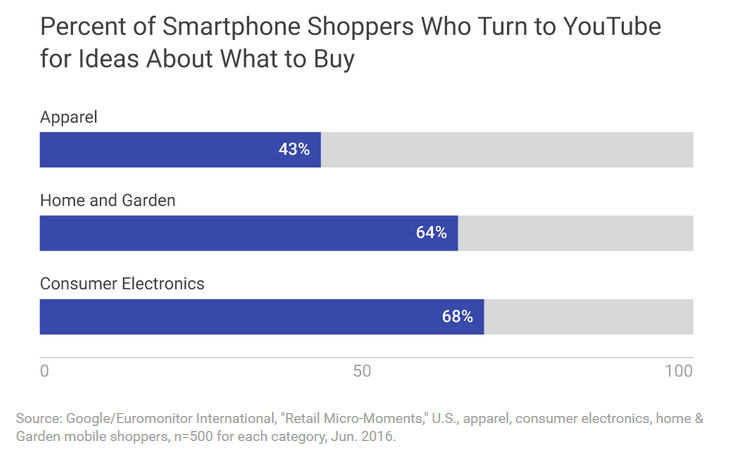
Gift guides are a huge presence online, and around 70% of the time, these kinds of videos are watched on mobile devices. Want to know how big of a presence online gift guide videos are? In the time people spent viewing them on YouTube last holiday season, you could watch “It's a Wonderful Life” well over 300,000 times.
Google calls these types of searches “micro moments” – essentially “being there” for a customer when, where and how they need you.
2. The Importance of “Micro Moments”
If you think micro moments are simply a customer going through the stages of Attention – Interest – Desire – Action, you'd be doing a huge disservice to what's actually involved in the process. Google took a look at one shopper's behavior to determine precisely how they interacted with various digital touch-points once they decided to do a basic search. Here's what they found:
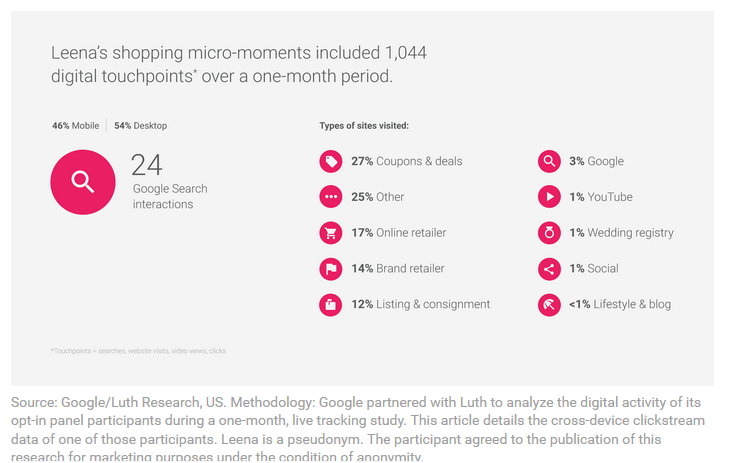
In this case, the shopper was Leena (a pseudonym), a 32 year old married woman from Washington state who looks for discounts and specials online. As you can see from the chart above, in a one month time period she hit over 1,000 digital touch-points. In taking a closer look at her search query, we can focus on a micro-moment. Leena had run out of mascara and was looking for an alternative to her regular brand.
She had narrowed down her decision to two choices. Then, her mobile search went like this:
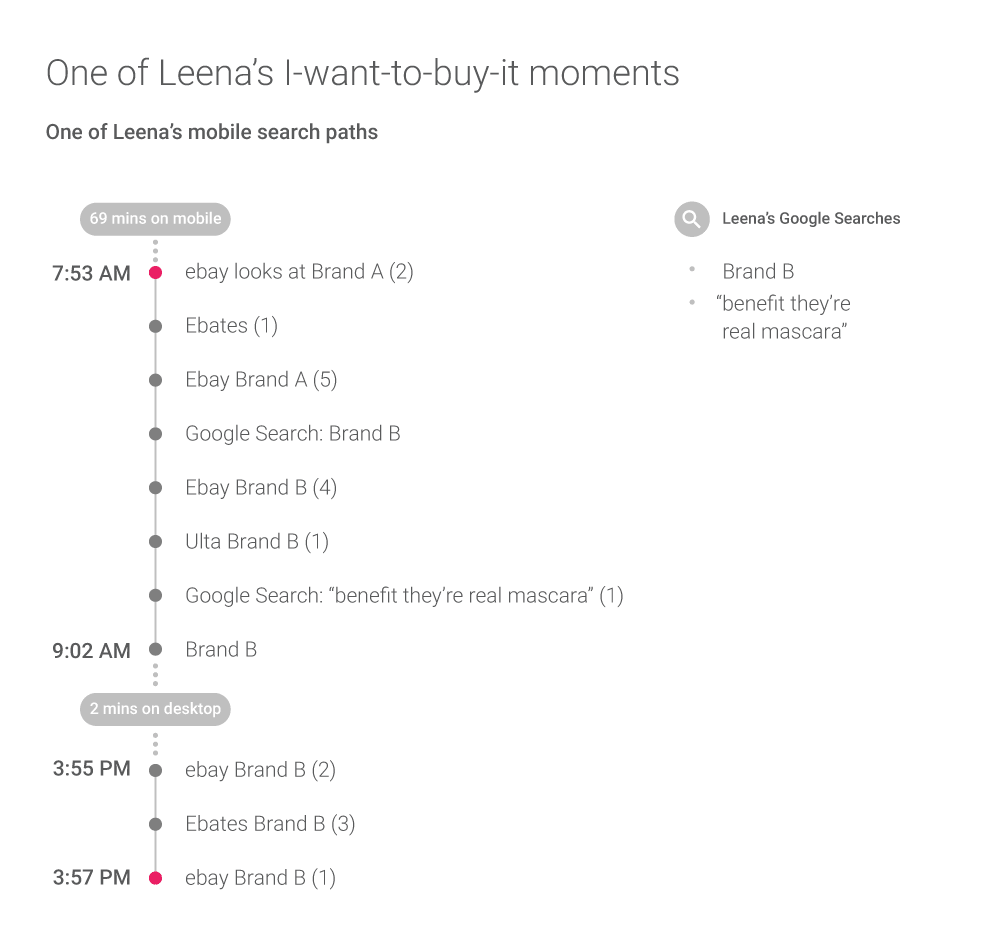
So as you can see, even on mobile devices, it's not a “once and done” process. It's a lot of back and forth, a lot of different devices, searches and comparisons being made.
3. Shoppers Ask: “How Will I Buy This?”
If you sell tangible goods, you may be worried that the holiday season is all about showrooming – trying on a product in your store, only to actually buy it on Amazon. But the truth is, whether you're serving customers locally or you're letting them shop on mobile (or both), the stores that offer the most convenience are the ones that ultimately get the sale. It is, in short, “frictionless shopping” – being there for the customer, right when, where and how they need you.
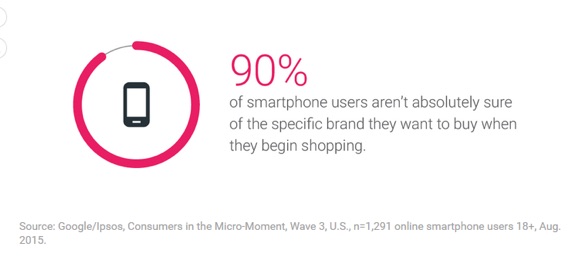
Contrary to popular belief, most of them don't even know what particular brand of item they want, which is why you need to be there during those micro-moments to help guide their decision: not in an overly sales-pressuring way, but in a helpful, convenient way. Google's own micro-moment inspiration guide shows how major brands like Swarovski crystal and catalog retailer Williams Sonoma do just that, by way of their online Style Finder (how to accessorize depending on the occasion) and rich media presentations of products respectively.

Free shipping is the biggest conversion booster we all know about. But “buy it online and pick it up in store” is another big one. Having multiple ways to get the product is great, but having multiple ways to pay for it is even better. Having the ability to not only accept credit cards, but Paypal and mobile pay systems like Android and Apple Pay are going to get you more conversions than sticking to a single system.
4. Consumers Only Want the Best
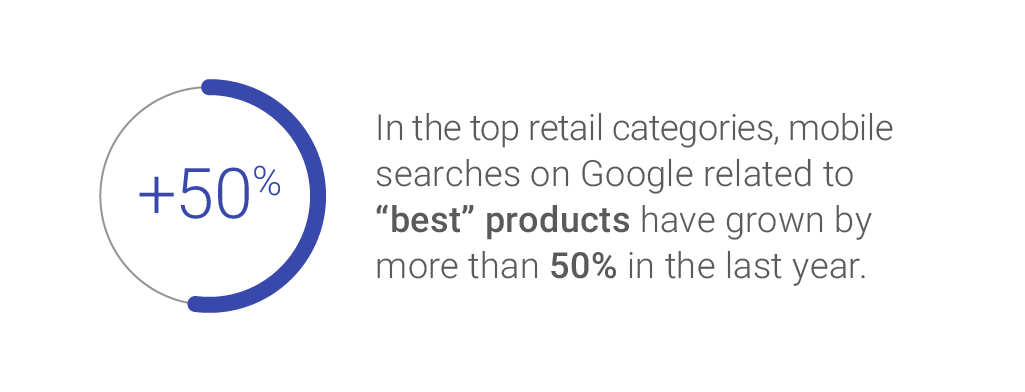
When buying online, you can't (yet) feel, try on or gauge the quality of a product. That's when shoppers are seeking out reviews and ratings – but even those can be bought. These days, consumers are shopping smarter by looking for the “best” of whatever gift they have in mind. Google reports that shopping queries with “best” have increased 50% in the last year. But simply claiming your product is the best isn't enough to win people over. Instead, show them.
For example, you could talk about what goes into making it or the features that truly make it stand out from the competition. What ingredients or qualities does it have that competitors tend to “cheap out” on? What makes your version worth their time and attention (and ultimately their wallets) and perhaps more importantly – are those differences the kinds of things that customers actually care about?
5. The Power of Cross-Device Targeting
As you can see from the touchpoint illustration above, there are a lot of back-and-forth choices to be made from mobile to desktop to mobile again. Throw in other items like TVs, gaming consoles, on-demand streaming, tablets and smart watches, and you get what marketers are calling the “multi-screen explosion”. Cookies just aren't enough to satisfy the hunger to glean info on customers anymore, so ad networks are ramping up their work on letting companies target customers across devices. Call it cross-device or multi-channel or omni-channel – it's changing the way we'll be shopping this holiday season.
But make no mistake – consumers are keen on privacy. There's a delicate balance between being personalized and convenient, and being too “in your face” with the messaging. Smart companies looking to reap the benefits of the holiday shopping season know that the best way to leverage upcoming trends is to hone in on customer behavior and preferences without that creepy stalker vibe.
In short, it means keeping customers (gently) informed, helping to guide them where possible and making things exceedingly convenient while providing the best possible experience as a whole. Sound like a tall order to fill? It is – and being able to juggle it across multiple customers and devices is no small feat. However, you can do wonders with this information by looking beyond the trend and brainstorming ways to turn your own products into the kind of convenient, accessible, relevant and engaging items that people won't hesitate to buy – for others, as well as themselves.
About the Author: Sherice Jacob helps business owners improve website design and increase conversion rates through compelling copywriting, user-friendly design and smart analytics analysis. Learn more at iElectrify.com and download your free web copy tune-up and conversion checklist today!

No comments:
Post a Comment